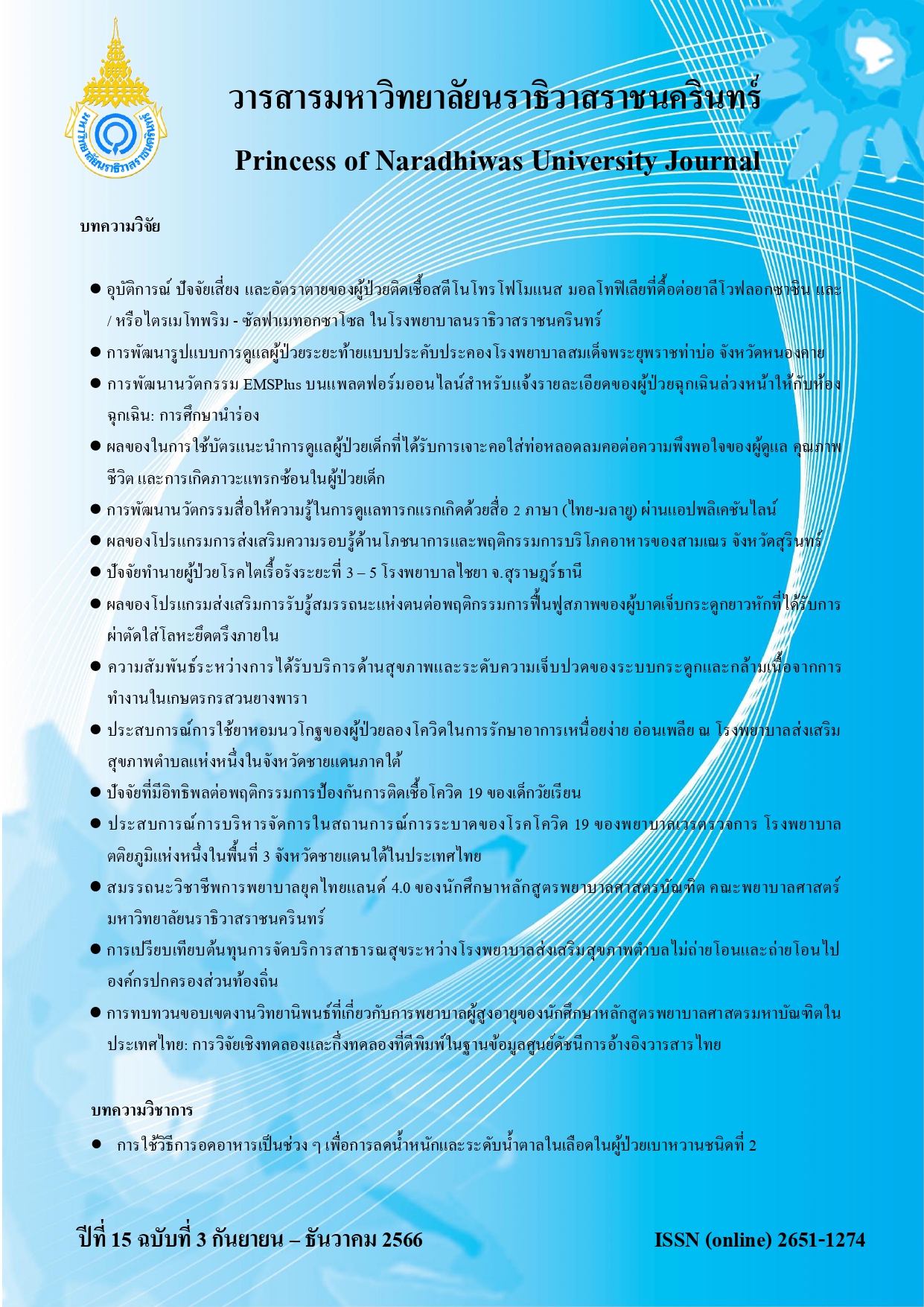The Experiences of Using Ya Hom Nawakot of Long covid Patients in the Treatment for Dyspnea and Fatigue at A sub-district Health promoting Hospital in the Southern border provinces
Keywords:
Experience, Ya Hom Nawakot, Long CovidAbstract
Most Long COVID patients have experienced dyspnea and fatigue. Thai traditional medicine has a guideline for treating with Ya Hom Nawakot to stimulate the circulation of the wind element in the body, which helps reducing the complications of Long Covid. This study was qualitative research to study the experience of using Ya Hom Nawakot of Long covid patients in the treatment of Dyspnea and fatigue. The informants were ten patients who had experiences of using Ya Hom Nawakot for not less than two weeks. Qualitative data had been collected for three months by observations and in-depth interviews, and follow-up on quality of life after receiving Ya Hom Nawakot treatment with the Thai version of the quality of life (QOL) questionnaire. Data were analyzed by content analysis.
The results showed that the contributing factor for the decision of patients to receive Thai traditional medicine treatment came from their symptoms of Long Covid that affected the quality of life, knowledge of health care and experience gained from the treatment. In terms of the effect of treatment with Ya Hom Nawakot, it was found that the symptoms of dyspnea were reduced, and fatigue were improved but there was a side effect as a slight heat in the stomach. The patients had a better attitude and acceptance of using herbal medicines. In the assessment of quality of life after treatment, it was found that the quality of life of patients was in the middle level.
The patients with symptoms of Dyspnea and fatigue from Long Covid even the condition has improved after being treated with Ya Hom Nawakoth, but most of them still had a moderate quality of life. Therefore, Thai traditional medicine practitioner should give an importance to the rehabilitation of mental, social and environmental treatment along with the treatment according to herbal medicine guidelines to achieve the effectiveness of better health care.
References
Chansangsa, S., Tansuwanwong, S., Taoprasert, Y., & Punfa, W. (2020). The Elderly’s Experience in “Lueadlompraepruan” Therapy by Yahom. Journal of Traditional Thai Medical Research, 6(2), 35-47.
Creswell, J.W., & Poth, C.N. (2018). Qualitative inquiry and research design: Choosing among five approaches. (4th ed.). Thousand Oaks, California: Sage.
Department of Medical Services. (2021). Post-treatment COVID-19 patient care (Post COVID Syndrome) or Long COVID condition for doctors and health personnel. Department of Medical Services, Ministry of Public Health. (in Thai).
Department of Mental Health. (2002). World Health Organization Quality of Life Indicators abbreviated Thai version. Nonthaburi: Department of Mental Health, Ministry of Public Health. (in Thai)
Department of Thai Traditional and Alternative Medicine. (2022). Thai medical practice guidelines for patient care COVID-19 and Post/Long COVID-19. Nonthaburi: Department of Thai Traditional and Alternative Medicine, Ministry of Public Health. (in Thai)
Food and Drug Administration. (2021). A guide to the use of drugs the National list of essentials drugs on Herbs. Phra Nakhon Si Ayutthaya: Greatest. (in Thai)
Mingmai, K. (2017). Knowledge Attitude and Herbal Usage Behaviors among Older People with Chronic Diseases in Tha Ruea District Phra Nakhon Si Ayutthaya Province. Wichcha Journal, 36(2), 56-69.
Noipha, K., Kamlungmak, S., Chaimay, B., & Suwannarat, R. (2017). Perception of Using Herbal Medicines in National List of Essential Medi- cines among Outpatients at Internal Medicine Department and Medical Doctors in Phatthalung Hospital. Journal of Thai Traditional & Alternative Medicine, 15(3), 333-351.
Phoomphong, C., & Chusak, T. (2022). Factors Related to Herbel use behaviors towards Self Care of Elderly in Thong En Sub-District, In Buri District, Sing Buri Province. VRU Research and Development Journal Science and Technology, 17(2), 89-103.
Prungpo, C., Khemthong, N., Srionjan, S., Mapong, K., Ramrit, T., & Distub, P. (2021). Herbal use behaviors in oral of village health volunteers Warin Chamrap Ubon Ratchathani Province. Thai Dental Nurse Journal, 32(2), 70-82.
Tantipasawasin, P., & Tantipasawasin, S. (2022). Post-COVID condition (long COVID). Chonburi Hospital Journal, 47(1), 67-84.
Taquet, M., Dercon, Q., Luciano, S., Geddes, J.R., Husain, M., & Harrison, P.J. (2021). Incidence co-occurrence and evolution of long – Covid features: A 6-month retrospective cohort study of 273,618 survivors of COVID-19. Plos Medicine, 18(9), e1003773.
Tarazona, V., Kirouchena, D., Clerc, P., Pinsard-Laventure, F., & Bourrion, B. (2022). Quality of life in COVID-19 outpatients: a long-term follow-up study. Journal of Clinical Medicine, 11(21), 6478.
Traditional Thai Medicine Rehabilitation Foundation. (2007). Original Thai medical texts (Pedsartsongkroh Conservation Edition) Volume 1. Bangkok: Supavanich Printing. (in Thai)
Wongwassana, S. (2021). Negative influential factors from Covid-19 pandemic on passenger service’s happiness in work: A case study of Bangkok flight services (BFS). Rajapark Journal, 15(39), 15-30.
University of Oxford. (2021). Over a third of COVID-19 patients diagnosed with at least one long-COVID symptom. Retrieved October 30, 2022 from https://www.ox.ac.uk/news/2021-09-29-over-third-covid-19-patients-diagnosed-least-one-long-covid-symptom.
Downloads
Published
How to Cite
Issue
Section
License
Copyright (c) 2023 Princess of Naradhiwas University Journal

This work is licensed under a Creative Commons Attribution-NonCommercial-NoDerivatives 4.0 International License.




